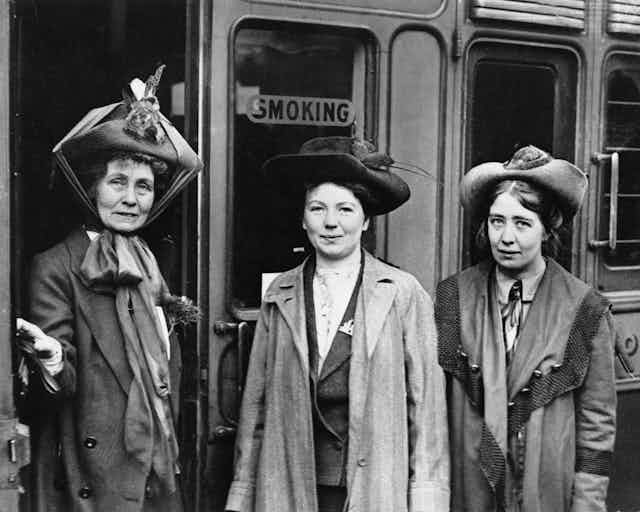Emmeline Pankhurst, her eldest daughter Christabel and some local socialist women founded, in 1903, the Women’s Social and Political Union (WSPU). Their goal was to campaign for the parliamentary vote for women.
The women-only WSPU, whose members were called “suffragettes”, became the most notorious of the various groupings campaigning for the vote – and the name “Pankhurst” synonymous with the suffrage struggle.
Emmeline Pankhurst, the inspirational leader of the WSPU, and Christabel, its key strategist, worked closely together during the suffrage campaign, always putting the women’s vote first. Both were charismatic figures and powerful orators who, with their cry of “Rise up women!”, roused thousands of women to demand their democratic right.
Yet the story about the suffragette campaign is not just a story about first wave feminism. It’s also a tale about family rifts and differing strands of feminism.
The dominant narrative about Pankhurst family life and the suffragette campaign is Sylvia Pankhurst’s book The Suffragette Movement, first published in 1931 and then republished in paperback in 1977. Written from a socialist feminist perspective, it reflects on her unhappy childhood when her sister Christabel was recognised as their mother’s favourite and also on her disagreements with her relatives about WSPU tactics.

The three Pankhurst women were all members of the Independent Labour Party (ILP) but Emmeline and Christabel became disillusioned with the way the ILP never gave priority to the women’s issue, despite its claim to support gender equality. When they resigned from the ILP in 1907, Sylvia was deeply upset. She wanted to link the WSPU to the socialist movement. Sylvia subsequently portrayed her sister in The Suffragette Movement as an evil Svengali who led their easily swayed mother away from the true path of socialism. She labelled separatist feminist Christabel a Tory.
The ideological differences between the Pankhurst women didn’t end there. Sylvia sought to fuse her feminism and socialism by forming, in 1913, a working-class grouping in the East End of London. Her East London Federation of the Suffragettes, although formally linked to the WSPU, followed its own independent line. It would not attack the Labour party nor Labour parliamentary candidates unsympathetic to women’s suffrage. Such a policy was too much for her mother and Christabel to stomach. In early 1914, Sylvia was expelled from the WSPU, a bruising encounter that she describes in great detail in The Suffragette Movement. She painted the WSPU as elitist and unattractive to working-class and socialist women.
Rethinking Christabel
Sylvia’s book, written as a rejected daughter and an angry socialist, was readily welcomed in the 1970s by left-leaning feminist historians who were influential in developing women’s history in the UK. The Suffragette Movement became the standard reading of events, accepted uncritically and rarely questioned. But there are other stories to tell.

In my most recent book, Christabel Pankhurst: a biography, I contend that Christabel was not a Tory, as Sylvia claims. She was a feminist who believed that the subordinate status of women in Edwardian society was due to the power of men (including socialist men). Consequently she saw the separatist, women-only WSPU as an important vehicle for women to foster a sense of sisterhood. It would enable them to stand on their own two feet and articulate their demands.
Christabel was a forerunner of “radical feminism”, a category of feminist thought that became pronounced in the second wave of the women’s movement in Western Europe and the US from the late 1960s. Thus, like second wave feminists who came after her, Christabel emphasised the power of men in a male-defined world and the importance of a women-only movement as a means for raising women’s consciousness. She prioritised the commonalities that all women share despite their differences, and believed in putting women first rather than considerations of social class, political affiliation or socialism.
Expressions of this feminist perspective can be found in many of the articles Christabel published during the suffrage campaign and in her own memoir, Unshackled: the Story of How We Won the Vote, which first appeared in 1959, one year after her death. Unshackled, with its matter-of-fact prose, was no literary match for Sylvia’s The Suffragette Movement. Nonetheless, Christabel wrote with passion and determination about her wish to free women from the stigma of inferiority that the denial of the vote embodied. She emphasised the uniting of all women as “one independent force” as the key reason why the formal link between the ILP and the WSPU was broken, at least at central level. Further in Unshackled, Christabel understated her own importance and emphasised the valiant role of her mother, to whom she was devoted.
Negotiating around these memoirs, when I was researching for biographies of both Emmeline and Christabel, was not easy. But from consulting a wide range of primary sources, a number of themes became clear. Emmeline Pankhurst was never the weak leader that Sylvia portrayed. Strong, passionate fiery and determined, she endured 13 imprisonments during the turbulent years of the suffragette campaign. And the charming, witty Christabel, with her wish to attract women of all political persuasions into the WSPU was not a Tory. Nor did the WSPU fail to attract working-class women and socialist women.
The twists and turns of the strong-minded Pankhurst women have fascinated people for many years, perhaps because it is within this family that we find the strands of thinking that have divided feminists in the past, and still do so today. But their memoirs also raise important issues about how rivalry among sisters can shape the stories they tell.

